Please Take Note: This is a review of the final game, but it might change slightly based on the success of the Kickstarter campaign. The game is being reviewed on the components and the rules provided with the understanding that “what you see is not what you might get” when the game is published. If you like what you read and want to learn more, we encourage you to visit the game publisher’s website or visit the Kickstarter campaign. Now that we have all that disclaimer junk out of the way, on with the review.
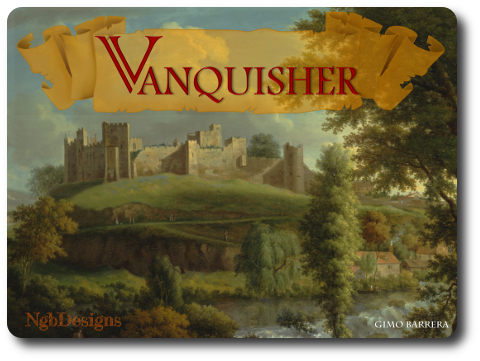
The Basics:
- For ages 10 and up (publisher suggests 14+)
- For 2 to 4 players
- Approximately 20 minutes to complete
Geek Skills:
- Counting & Math
- Logical & Critical Decision Making
- Reading
- Strategy & Tactics
- Visuospatial Skills
- Cooperative & Team Play
- Hand/Resource Management
- Trading
- Worker Placement & Area Control
Learning Curve:
- Child – Easy
- Adult – Easy
Theme & Narrative:
- Victory comes at a cost (normally wood, gold, stone, or metal)
Endorsements:
- Gamer Geek approved!
- Parent Geek approved!
- Child Geek approved!
Overview
Noted poet, novelist, and historian William Gilmore Simms said, “The true law of the race is progress and development. Whenever civilization pauses in the march of conquest, it is overthrown by the barbarian.” In this game, conquest at any cost is the aim. To build their kingdom, players must forge new paths into unknown land, forge alliances, and gather resources as quickly as possible. The race for conquest has begun and woe to those who cannot keep up!
Vanquisher, designed by Gimo Berrera and to be published by NgbDesigns, will reportedly be comprised of 280 Construction cubes, 40 Farmer meeples, 64 Army tokens, 1 die to help randomize outcomes, 1 Year Tracker (a standard twelve-sided die), 4 City Hall cards, 64 “Basic” Blueprint cards, 90 “Auction” Blueprint cards, 90 Bribery cards, 1 game board, 32 Lumber Tokens ( in the values of 1 and 5), 32 Stone Tokens (in the values of 1 and 5), 32 Metal Tokens (in the values of 1 and 5), and 48 Coin tokens (in the values of 1, 5, and 10). As this is a review of a prepublished game, I will not comment on the game component quality. The illustrations on the cards, which might not be final, do an excellent job of capturing the card’s theme, making it easy to identify the card’s role in the game.
A New Land to Conquer
To set up the game, first place the game board in the middle of the playing area.
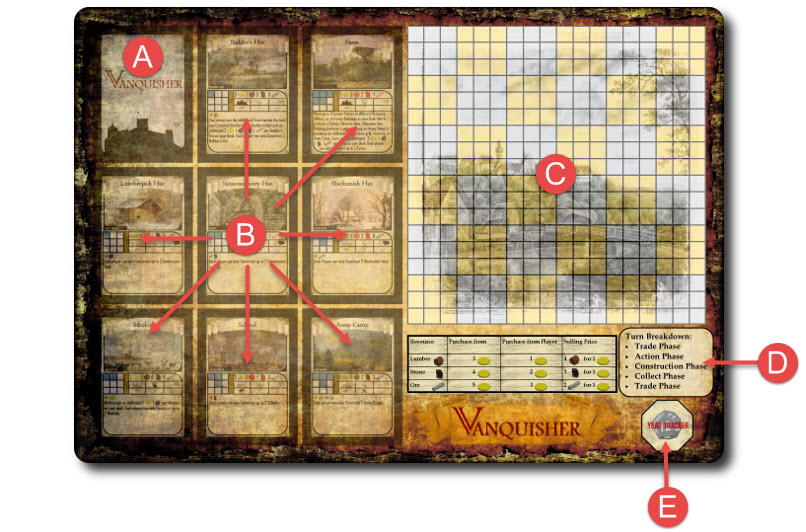
A) “Auction” Blueprint game board spot
B) “Basic” Blueprint game board spots
C) Game board grid area
D) Player turn order and Trade summary
E) Year Tracker space
Second, take the “Auction” Blueprint cards and shuffle them. Place the deck of cards face-down on the game board on the “Vanquisher” titled spot. Make certain this deck of cards is within easy reach of all players. Draw the top 8 “Auction” cards and place them face-up next to the game board.
Third, place 2 “Basic” Blueprint cards per player on their matching spot on the game board, face-up. Any “Basic” Blueprint cards not placed are set aside.
Fourth, shuffle the Bribery cards and place them face-down next to the game board. Leave room for a discard pile. At this time, also set the Gold, Lumber, Stone, and Metal tokens into resource supply pools. I suggest you put them into small cups to make it easier to manage your table space. The area where the tokens are kept is referred to as the “Trade Depot”. Give each player 3 Gold, 3 Lumber, 2 Stone, and 1 Metal from the Trade Depot. Players take the tokens and place them directly in front of them. This area in front of the player is referred to as the “Player’s Reserve”.
Fifth, give each player 9 Farmer meeples, 75 Construction cubes, and 16 Army tokens of a single color. These are placed in the Player’s Reserve.
Sixth, place the Year Tracker on its designated game board space with the die value of “12” face-up.
Seventh, each player takes 1 City Hall card and places it in front of them next to their Player’s Reserve. This area is referred to as the Player’s Desk (it’s where players will keep their cards). The players then take 2 Construction cubes and place them on the game board grid, matching the Shape noted on the City Hall card.
That’s it for game set up. Determine who will go first and begin your conquest!
A Brief Look at the Cards
Vanquisher has 3 different card types. These are used to help the player move further into the new land, claim it as their own, and defend it from would-be rivals. It’s important to note that a player cannot hope to obtain and keep the lands they conquer on their own. They will require help, but help comes in different forms. Sometimes it’s building armies and equipping them and sometimes it’s a subtle bribe to an official that helps make certain “problems” disappear. The players will also need to gather support from noted officials and nobles to help champion their cause back home.
The “Basic” Blueprint Card
Blueprint cards give the player the option of building whatever it is the card represents. The “Basic” Blueprints are available to all the players, making them a common construct on the game board. They also allow players to build additional structures, sell resources, and collect resources. But this all comes at a cost and there are limitations.
For example, each player starts the game with the City Hall card. This is a “Basic” Blueprint card and the only one the players will get for free, but all other cards are more or less an offshoot of it.
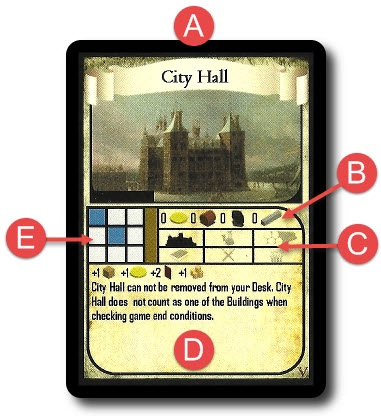
A) The name of the card. Players are sometimes limited to the number of cards they can have during the game.
B) The cost to bring the card into play. Payment is taken from the Player’s Reserve and often includes a mix of Gold, Lumber, Stone, and Metal tokens.
C) The Blueprint card type. There are six different types in total. These are Kingdom, Currency, Resource, Educational, Military, and Religious. The player will be using these types to help determine if certain cards can come into play and where they stand in relationship to their opponents’ strength.
D) The effects of the card. Some effects must be paid for to be triggered while others are conditional.
E) The Blueprint shape. This represents a small 3×3 section of the game board grid. The player must be able to play Construction cubes to the game board that matches the shape shown. The shape need not be identical. Players can rotate the Blueprint card to help find an open space to build, but they cannot “mirror” the shape shown.
The remaining “Basic” Blueprint cards are shown face-up on the game board. There are a limited number available, but depending on a player’s strategy, they may only need a few to get started. Each of the “Basic” Blueprint cards is meant to establish a base on which the player will build their conquesting engine, but not every engine is build the same.
The “Auction” Blueprint Cards
The “Auction” Blueprint cards are more complex versions of the “Basic” Blueprint cards. They work the same way, however, and tend to specialize in one the Blueprint card types. They cost more to build and take more Construction cubes (which, if you recall, is a limited resource), but they provide much bigger and better bonuses. Like the “Basic” Blueprint cards, the “Auction” Blueprint cards are diverse and provide many different things, but one card is not better than another. Their worth will depend on the player’s strategy.

The Bribery Cards
Bribery cards share many of the same characteristics as the Blueprint cards, but are not constructed. These cards represent people of influence and power. Temporary Bribery cards are discarded face-up once they are played, while the permanent Bribery cards remain face-up in the Player’s Desk area and continue to provide whatever bonus that is listed on the card. Some Bribery cards must be paid for before they can be brought into play. The required payment could be Gold or other resources, but might also include the player’s army. If the player pays with their army, this is referred to as “Threatening” the Bribery card, which removes a certain number of the player’s Army tokens, but gets the job done.
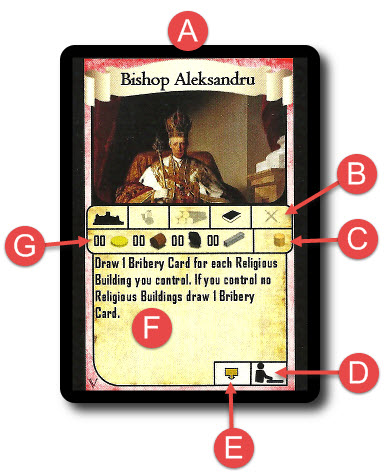
A) Name of the official being bribed. These range from scholars to politicians, church officials and members of nobility.
B) The Bribery card type. There are six different types in total. These are Kingdom, Currency, Resource, Educational, Military, and Religious.
C) Alternative Threatening cost. The player can destroy one or more of their standing Army tokens in play if they would rather not bribe the official using other resources.
D) The character’s influence.
E) The duration of the Bribery card (temporary or permanent).
F) The effects of the card.
G) The cost to bribe the character (paid out of the Player’s Reserve and sent to the Trade Depot).
Armies of Conquest
Army tokens are used as roadblocks on the game board grid, reducing an opponent’s ability to construct Blueprints. Army tokens are earned during a player’s turn and can be placed to any free space on the game board grid (or on top of an existing Army token), but the total number of Army tokens a player has is limited.
Once placed, an Army token restricts construction. For example, Player 1 places a red Army token on a free space. The grey areas around the red Army token are now off-limits. Player 2 with the green Construction cubes will have to find a way to build around the Army or remove it if they want to keep constructing without being hindered.
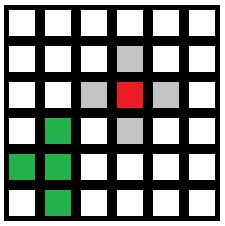
All “Ready” Army tokens start on the Player’s Desk after being taken from the Player’s Reserve. From their they are moved to the game board grid which makes them “Active”. Ready and Active Army tokens can be destroyed to remove an opponent’s Ready or Active Army tokens. This is always done using the 1:1 ration (i.e. “I kill your army and your army kills my army”). Destroyed Army tokens are placed back in the Player’s Reserve, but by that time the damage to the opponent has already been done.
Army tokens can be “stacked”. The Army tokens take up the same amount of space on the game board grid (in this case, 1 square), but they are twice as strong as your regular army. It takes 2 or more opponent Army tokens to remove them from the game board grid.
To Vanquish Your Enemies
Vanquisher is played in rounds. Each player has 1 turn per round. At the end of each round, the Year Tracker value is reduced by “-1”. A single game will consist of 12 rounds.
A player’s turn consists of 5 sequential phases. The phases are summarized on the game board to help players keep track of what they need to do, but most of the player’s attention will be on their Player’s Desk, especially towards the end of the game. A player’s turn is summarized here. Any of the phases may be skipped, but they must be played and skipped in the order listed.
Phase 1: Trade
At the top and bottom of each player’s turn, they have the option to trade (i.e. “sell”) their resource back to the Trade Depot at a set price, as are the quantities of resources that can be sold at a time.
If the player likes, they can buy resources from their opponents. An opponent can never refuse to sell resources to the player, no matter how they feel about them. The Trade Depot is still used, but acts as a sort of “Middle Man” as the player and their opponent exchange resources. The only limitation is that the opponent must have the ability to produce the traded resource using one of their built Blueprint cards.
Phase 2: Take Actions
Blueprint cards, once built, can provide actions. At the start of the game, each player has 2 actions thanks to their City Hall card. Additional actions can be earned using Bribery cards and building other Blueprint cards. Actions allow the player to do any of the following.
Draw One Bribery Card
This action allows the player to draw 1 Bribery card from the Bribery card draw deck. The Bribery card is taken into the player’s hand, which is referred to as the “Player’s Shelf” in the game. The player does not show the Bribery card to their opponents, but they must keep track of how many they have, as the total number of allowed Bribery cards the player can keep is restricted.
Pick Up One Face-Up Blueprint Card
This action allows the player to pick up any face-up Blueprint card and add it to their “Player’s Drawer”. A Player’s Drawer is an area off to one side of the player where Blueprint cards they have obtained are kept face-down. There is no limit to the number of Blueprint cards a player can have in their Player’s Drawer, but any not used will penalize the player at the end of the game.
Draw One Blueprint Card from Auction Blueprint Deck
This action allows the player to draw 4 “Auction” Blueprint cards from the deck (not those shown face-up), select 1, and place the remaining 3 at the bottom of the “Auction” Blueprint deck in any order they like. The selected Blueprint card is placed in the Player’s Drawer.
Play One Bribery Card from Player’s Shelf
This action allows the player to play 1 Bribery card from their Player’s Shelf and put it into play. The player must pay the Bribery cost or the Threatening cost before the card is played. After the proper number of resources are paid, the Bribery card is activated and is either placed in the discard pile (if temporary) or placed in the Player’s Desk area (if permanent).
Move One Army
This action allows the player to move any number of their Active or Ready Army tokens to any open space on the game board grid. They can also place an Army token on top of one of their own Army tokens, stacking them in the process.
Fight Opponent’s Army
This action allows the player to attack an opponent by using their Army tokens. The player can use their Army tokens as many times as they like for the cost of only one action, but all combat must be done at the same time. Any Army token that falls in battle is returned to the Player’s Reserve.
Phase 3: Construction
During this phase, the player has the option of building infrastructure to help with their campaign. Any face-up Blueprint cards can be purchased and constructed. This includes the “Basic” Blueprint cards and any still remaining “Auction” Blueprint cards. Purchased “Auction” Blueprints are immediately replaced by drawing a new “Auction” Blueprint card. The player can also use any Blueprint from their Player’s Drawer. Payment is sent to the Trade Depot.
A player can construct as many times as they are allowed by Blueprint and Bribery cards. By default, players are only allowed to construct 1 additional Blueprint per turn. This is provided by their City Hall card.
Constructing the purchased building is the next step. This done using the number of Construction cubes shown on the Blueprint card and making an identical pattern as the Blueprint card’s shape. At least 1 Construction cube used during the Blueprint construction must be adjacent to any other Construction cube owned by the player. “Adjacent” does not mean the sides of the cubes are touching. Rather, only the edges of the cubes should be touching. If the player is unable to do this, the player cannot construct their Blueprint and bring it into play.
For example, Player 1 is using the red Construction cubes. He is able to build his next Blueprint by connecting two buildings together. Note that Player 1 built around Player 2’s Construction cubes, which are shown in green.
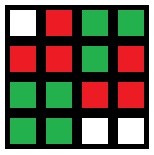
Phase 4: Collection
The player now collects the resources generated by their constructed Blueprint cards and possibly a Bribe card or two. Resources are taken directly from the Trade Depot and placed in the Player’s Reserve. If the Trade Depot is out of a resource type, the player cannot collect it. The only exception to this rule is Gold, which is considered always available. If there are no other Gold tokens available, the players will need to use some other token to temporarily make due.
Players can also produce Army tokens during this phase by taking 1 Army token from their Player’s Reserve and placing it in their Player’s Desk area. Normally, Army tokens are placed on a Blueprint card to help keep track of the player’s total Army capacity. Army capacity is determined by the Blueprint cards in play and limits the number of total Army tokens the player can have on the game board and in their Player’s Desk area.
If the player has more than 4 Bribery cards in their Player’s Shelf, they must discard down to no more than 4 at this time and before continuing to the next phase.
Phase 5: Trade, Again, or Don’t
This is a repeat of phase 1 noted above. It can be skipped or the player can trade as much as they can.
The player’s turn is now over. The next player in turn order sequence now takes their turn. Once all the players have taken their turn for the round, a new round begins with the Year Tracker value being reduced by -1.
A Cause Fought and Won
The game can end 1 of 3 different ways:
- The first player to construct their 16th Blueprint triggers the endgame. The round is completed and players move to scoring.
- If a player is ever unable to construct any face-up “Auction” Blueprint cards during the Construction phase due to lack of available space on the game board, the endgame is triggered. The round is completed and players move to scoring.
- If the Year Tracker die is reduced to “zero” (12 rounds have been completed), the game is over and players move to scoring.
Players earn Kingdom Points (KP) during the game and at the end of the game. KP is earned from certain Blueprints, having territorial advantage on the game board, the total amount of Gold still in the Player’s Reserve, and completing “Feats”, which are additional bonuses. For example, the “Knight” Feat is given to the player with the most Army tokens.
The player is then penalizes -5 KP for every Blueprint they still have in their Player’s Drawer. This means a player is welcome to take as many Blueprints as they want during the game, but their will be consequences for those conquerors who reach further than their means.
Once all the KP is added together, the player with the most KP wins the game!
Game Variants
Vanquisher has a number of variants. Each is summarized here.
Three-Player Games
When only playing with 3-players, a fourth of the game board grid is sectioned off, reducing the total amount of space the players have available to build. The only other change is that the player who is between two other opponents on the game board (based on initial placement of their City Hall) will always be the first player.
Two-Player Games
Like the 3-player game variant, the 2-player game variant removes a portion of the game board grid from play. Half of grid is sectioned off. Players build their initial City Hall in opposite corners. No other changes to the rules.
Adventure Mode
Instead of having a limited number of rounds, the Year Tracker is not used. The game ends when either of the two other endgame conditions are met.
Versus
This game variant requires 4 players and puts them into teams of 2. Teams build their City Halls in the middle of the game board grid, with teams building their City Halls adjacent to each other. Team members take their turns at the same time, but do not share resources, Player Shelves, Player Drawers, or Player Desks. Team members are welcome to talk to each other, work on strategies, hammer out tactics, and show cards. At the end of the game, KP for each team member is calculated separately and then added together to determine their team score. The team with the most KP wins the game. No other changes to the rules.
To learn more about Vanquisher, game publisher’s website or visit the Kickstarter campaign.
Final Word
I was concerned for the Child Geeks. This appeared to be a big game when I took it out of the box. Lots of cards and lots of bits. To my surprise and delight, the game slowly ramps up and the basic rules are easy to remember. Each card adds to the existing rules, making the learning curve exceptionally small. As such, none of our Child Geeks had a problem learning and playing the game. According to one Child Geek, “I can’t decide what part of the game I like more. The construction or thinking about all the different cards I can buy.” Another Child Geek said, “The only part about this game that I don’t like is that I can’t build really big and really fast. I have to work up to it.” Which is actually not a bad thing. The only aspect of the game the Child Geeks didn’t enjoy is how serious the game turns halfway through. By that time, all the players know exactly what they are doing and space starts becoming an issue. At first, everyone has room, but as the game progresses, players will start competing for resources and building locations, turning the game rather cutthroat. As one Child Geek put it, “If you didn’t pay attention during the first half of the game, the second half is going to be really horrible.” The more casual Child Geeks felt that the game was too much for them, but the majority loved it. Vanquisher was approved by the Child Geeks.

Our first game – my little conqueror scans the table for just the right Blueprint card to collect
The Parent Geeks were pleasantly surprised how easy the game started and then ramped up its difficulty each round. One Parent Geek said, “I really like games like this. Games that build upon itself and what players do. That means the game will be different every time and the players always have both hands on the game’s level of difficulty.” Yes, but the game responds to ALL the players, not just the group. This means one player could have a different game than their opponent. It all depends on how the player is building and what their goals are. Another Parent Geek said, “I thought this game was going to be much more difficult when you first explained it. Now I see that it’s a game that becomes difficult, but only as much as the player makes it.” Like the Child Geeks, some of the non-gamer Parent Geeks felt that the last half of the game was a bit too difficult and stressful, which really meant that this particular group built themselves into a corner and couldn’t figure out how to escape. They rejected the game, but the majority sung its praise. The Parent Geeks voted to approve Vanquisher.
The Gamer Geeks understood how to play the game very quickly and got to it, testing every nook and cranny in an attempt to break it or find some sort of flaw. After the first game, the only flaw the Gamer Geeks found was that a more aggressive player was somewhat restricted during the first half of the game. According to one Gamer Geek, “I appreciate that the game slowly ramps up, but it ramps up a bit too slowly for me. I want to get in, get things done, and trap my enemies. I can’t seem to do that as fast as want and I find that frustrating.” Another Gamer Geek said, “This game is all about the slow burn, but you can control the heat and the speed in which it increases. To a limit. I always felt in control, but I also felt the need to act swiftly. I really liked that.” All the Gamer Geeks agreed that Vanquisher was a game that had great depth, required cunning strategy, and tactical prowess to beat opponents, but not all the time. The game’s difficulty was directly proportional to an opponent’s ability. If the Gamer Geeks played against other Gamer Geeks, the games were rough and tough. Against more casual players, the Gamer Geeks found Vanquisher to be a walk in the proverbial park. Regardless, all the Gamer Geeks enjoyed themselves during their games and voted to approve Vanquisher.
Vanquisher feels like several different games in one, blended together perfectly to create a game that plays casually, but has a lot of depth. For those that enjoyed the strategic and tactical game play provided by Blokus or City Square Off, the construction phase will certainly entertain and engage. The Card game aspect is an exercise in building the perfect engine to keep the player’s lofty ambitions afloat. Each Blueprint provides something specific, but not necessarily unique. By combining them, the player earns resources, but they must balance their need to acquire with the shrinking space available to build. And it’s the reduction or limitation of resources throughout the game that the players will quickly start to obsess about. There is only so much space and only so many resources to go around. Which makes the entire game feel like a strange exercise in adding and subtracting. If you want this resource, you have to sacrifice that resource. If you broke it down, I’m sure you could put the entire game into a spreadsheet and all the calculations could be done for you.
But it never feels that complicated. Difficult, certainly, but not complicated. The choices to be made grow gradually more and more complex as the player expands. The learning curve is balanced with the player’s progress. If they don’t do much, they won’t have much to think about. The more they do and grow, the more they must manage and maintain. Sounds a bit stressful, if the truth be told, but nothing is jammed down the player’s throat. Again, the game expands and contracts based on the player’s actions. The player is never out of their comfort zone because the dimensions of it are always based on what the player is doing. In short, the player will push themselves. The game won’t.
I am very pleased with Vanquisher. It hit all the marks for me when playing with my three groups. For the Child Geeks, it gave them enough information to make important and meaningful choices, ramping up the difficulty level at an enjoyable and manageable pace. For the Parent Geeks, the game play started smoothly and continued to play casually, even as the players became more aggressive, asserting their claim on the territory before them. For the Gamer Geeks, the game amused, entertained, and challenged all at the same time. Like the Parent and Child Geeks, the game expanded based on the players who pushed its limits. The Gamer Geeks pushed hard and fast and the game didn’t even stumble. Aggressive game play was just as balanced and as smooth as casual game play. In fact, all three of our groups played the same game three different ways, but not one of them would tell you they played a different game.
Vanquisher is one of those games you will keep playing and playing as you try new ways to trick, trap, and tromp your opponents. Each game was unique, each decision was different, and even if victory wasn’t won, none of the players left the gaming table feeling like they lost. Challenging, deep, tricky, tactical, and just a lot of fun, do try Vanquisher when you get the time.
This is a paid for review of the game’s final prototype. Although our time and focus was financially compensated, our words are our own. We’d need at least 10 million dollars before we started saying what other people wanted. Such is the statuesque and legendary integrity of Father Geek which cannot be bought except by those who own their own private islands and small countries.



